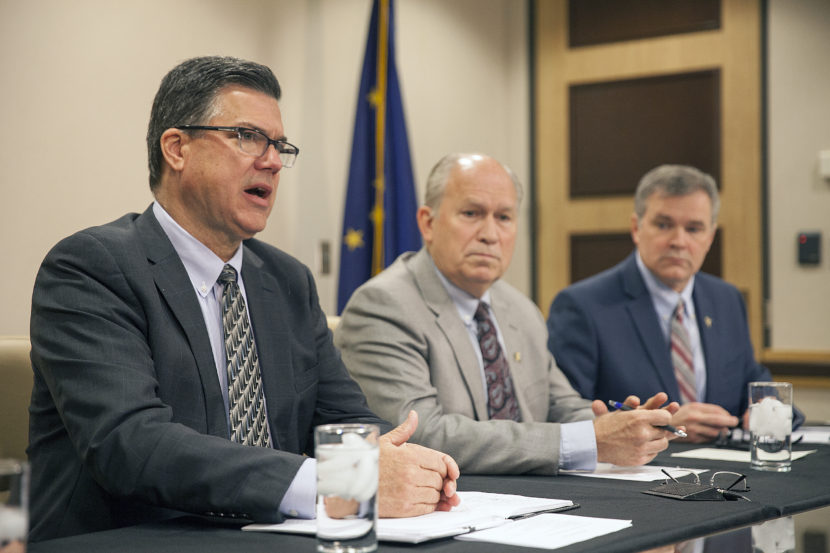
For the last two months the state’s gasline corporation has asked potential customers and investors in the state-led project to formally show interest in the massive pipeline project, without being bound by a contract.
It’s called an open season, and it has been a chance for the state to get an idea of just how much the global market wants Alaska’s gas.
And while the state corporation and the governor are optimistic, some lawmakers aren’t sure there has been enough interest to continue pouring state money into the $45 billion project.
Last year, Gov. Bill Walker told a reporter at the Alaska Dispatch News that he would give the state-run LNG pipeline project a year to find its footing and a market for the state’s North Slope gas reserves.
And it has been a busy year. Walker said, once the state started meeting with other countries, without a company as an intermediary, things really heated up.
“I think it really started with a meeting with President Xi, President of China, when he came to Alaska, expressed his interest in LNG to China,” he said.
Walker and members of Alaska’s Gasline Development Corporation have zipped back and forth to Washington D.C. and Singapore and Korea. They opened an office in Tokyo. And Walker said, he’s encouraged by what he’s hearing.
“Never in my wildest dreams would I have thought we would have this kind of market engagement,” Walker said. “And again it’s the first time we’ve really engaged market to market. We’ve always done it through somebody else, a producer or someone who has a competing project elsewhere in the world. And now we’re doing it sort of sovereign to sovereign and I think it’s been very, very, very successful.”
But, he stopped short of saying whether he thinks the state corporation should go to the legislature for more funding this year.
“We’ll look and see if that’s warranted or not,” he said. “It’s probably too soon to say on that.”
Right now, the corporation has a budget of just over $100 million dollars
There is a $102 million spending plan for Alaska’s gasline projects.
The Alaska Gasline Development Corp. board of directors unanimously approved the budget at its Thursday meeting in Anchorage. The plan would exhaust the state’s two gasline funds over the next 18 months or so.
As Walker’s soft deadline approaches, the state corporation tasked with finding customers and investors to build the mega-project said it has gotten some good news.
Last week, they reported signing confidentiality agreements across six different markets.
The federal government said the project qualifies for a program that streamlines the permitting process. The corporation also got an opinion from the IRS that said it’s likely to be tax-exempt.
And the corporation signed a memorandum of understanding, or MOU, with a Korean gas corporation. It’s basically an agreement that the two corporations could work together as the project develops.
Still, the project is a tough sell to lawmakers who control where the state’s money goes.
Some, like Senate Republican Kevin Meyer, say it’s not clear if any of the steps the corporation or the governor have taken are going to make the project cheaper or more attractive to investors.
“That’s kind of the big unknown is what does that apply to and how much does that apply to,” Meyer said. “I know the governor kind of a made a big thing about it but, you know, he also made a big thing about this MOU’s which are basically meaningless.”
So far, the state and its former oil company partners have spent more than half a billion dollars studying the project, trying to figure out if it’s feasible.
“We want to be excited and positive and optimistic about the project but yet we also want to be real and objective because it’s, it’s a big project and it has already cost a lot of money that we don’t have,” Meyer said.
Last year, both the House and Senate mulled proposals to strip millions from the state corporation’s budget.
Meyer said lawmakers just don’t have enough information to know if the state can afford to keep pushing the project forward.
And on the other side of the aisle, House Democrat Geran Tarr agrees.
Tarr said she thinks that patience is wearing thin in the legislature, in part because of the state’s multi-billion dollar budget deficit.
As lawmakers cut funds for education, power in rural areas, and student scholarships, Tarr said it can be hard to justify spending millions of dollars on a project that they can’t be sure will even be built.
“Can we afford to do it right now while we’re still trying to fix our other major financial problems? And, is now the right time given the market conditions? We know that that resource is not going to go anywhere. It’s going to be there. And I fully believe it will be developed … it’s a matter of the timing,” Tarr said.
The corporation is supposed to give a progress report to the legislature in September. And Tarr said she thinks that meeting will be full of detailed questions about just who is interested in Alaska’s gas and just how much money the state will be expected to pay to develop the project.
She said she hopes they’ll get some answers.
Rashah McChesney is a photojournalist turned radio journalist who has been telling stories in Alaska since 2012. Before joining Alaska's Energy Desk , she worked at Kenai's Peninsula Clarion and the Juneau bureau of the Associated Press. She is a graduate of Iowa State University's Greenlee Journalism School and has worked in public television, newspapers and now radio, all in the quest to become the Swiss Army knife of storytellers.




